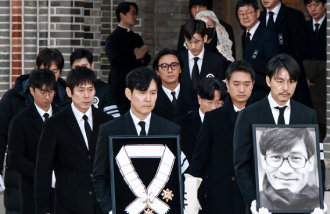One Hundred Percent Employment Rate
One Hundred Percent Employment Rate
Posted December. 06, 2005 06:47,
"Other people pay money to study overseas, but I have realized my dream of working in my area of interest and the place where I enjoy working." Goh Joo-hyeong is enrolled in the IT masters program run by the Trade Academy of the Korea International Trade Association (KITA). Last year was hard on Goh. His classes, projects, and self-studying comprised more than 12 hours a day, which fatigued him. He couldn`t even rest on the weekends because of the heavy study load. The only vacation he took was a week off during the summer. But those hard times have definitely paid off. He has recently accepted a job offer from ISF Net, a leading network service company in Japan, and he plans to start in January next year. Intermediate Japanese language skills and four IT certificates are just a bonus trophy to the employment.
The Legend of the 100 Percent Employment Rate
Goh`s classmates` job placements are almost confirmed. Among the 93 people who completed the program this month, 88 had sought jobs overseas and all of them landed jobs in about 12 Japanese IT corporations, including Kosmo Consulting. The remaining five have secured a job domestically and are exploring his or her options in the recruitment process. During the last four years, the average employment rate of those who have graduated the program is 99 percent. In particular, over the last two years, the employment rate for those seeking jobs in Japan is 100 percent.
The director of the Trade Academy Lee Chung-gi said, "People who finish the program mostly work overseas and receive over $30,000. Some already work as project managers, which is the equivalent of a team manager position in Korea. In the past, those students who finished the program went to Japan for interviews. Nowadays, the situation has reversed, and recruiters come from Japan to introduce their companies and conduct on-site interviews. Moreover, every year, three to four companies show interest to those new students.
Sparta Style of Discipline and the Customized OJT
The daily activities of the students begin at 8:00 a.m. If anyone is late, on the following day, the start time of the morning assembly will be 10 minutes earlier. After that, regular classes such as Japanese, computer programming, and self-studying continue until 9:00 p.m. Lecturers are Japanese who have worked in the IT area for more than three years. The teaching hours of the year-long program reach 2,200 hours a year, which is more than that done during four years of college teaching hours. Since the program is quite demanding, there are drop-outs. The academy said, "More than half of the students enrolled in the program come on the weekends to study , and the drop out rate is about 15 percent." One of the merits of the program is that it fosters practical talents. After theoretical lectures, projects always follow. Moreover, the academy holds roundtable discussions with the representatives of the Japanese corporations two or three times per year, and after taking the companies requests, they include them for the next term.
Jae-Dong Yu jarrett@donga.com




![반찬통 착색 고민 끝…‘두부용기’ 버리지 말고 이렇게 쓰세요 [알쓸톡]](https://dimg.donga.com/c/138/175/90/1/wps/NEWS/IMAGE/2026/01/09/133126593.3.png)


